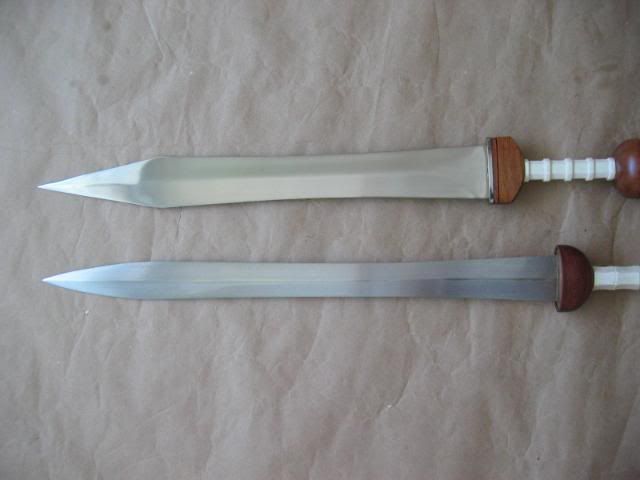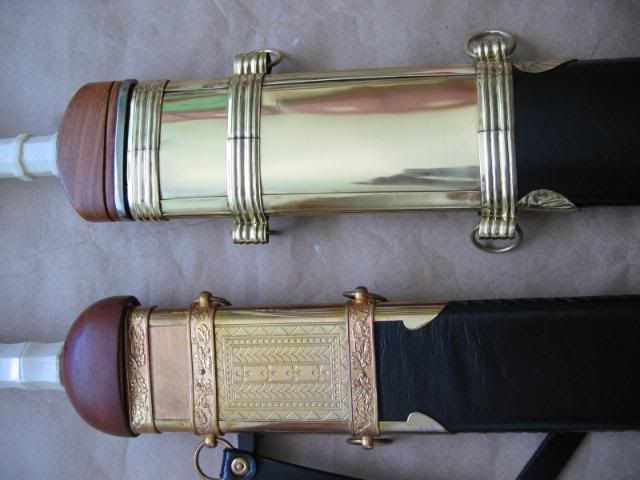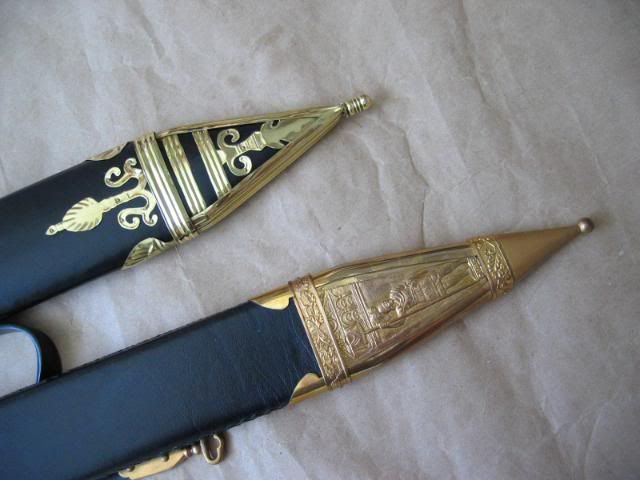Comparison Review: Hanwei vs MRL Mainz Gladius
Jan 28, 2009 16:43:31 GMT
Post by Deleted on Jan 28, 2009 16:43:31 GMT
Comparison Review – Hanwei vs MRL Mainz Pattern Gladius - Larry
I like to collect swords that are representative of various era/ethnic groups because they make good conversational pieces whenever there are guests to our house and, the Roman Gladius (‘Gladius’ is a Latin word for ‘sword’) is one such. Of the different Gladii (plural for ‘gladius’) variaties, I like the Mainz Gladius the most and, it’s only until recently, I had the opportunity to own 2 such pieces – both from different makers – so I thought it may be interesting to do a comparison review here. I will also attempt to determine the historical authenticity amongst these two production pieces with the feeble knowledge I acquired through books and Internet.
Brief History of Mainz Pattern Gladius– Extracts from Wikipedia & various Internet sources
“The Mainz pattern Gladius (so named because the first models of this type of swords were found in the city of Mainz, Germany) was, chronologically, between the Gladius Hispaniensis and Pompeii Gladius. The blade of the Mainz Gladius is wide, deeply waisted and has a long point section like the earlier Gladius Hispaniensis, but is shorter and broader than its predecessor. It is believed to have developed from the leaf-bladed short swords used by the Celt-Iberian (modern Spain) and adopted for use in the Republican Legions.
The Roman legions fought by massing together with overlapping shields and each soldier generally led with his shield and thrust with his sword from behind the protection of the shield. Despite being designed primarily as a thrusting weapon, the gladius appears to have been suitable for slashing and chopping motions, too.”
The Swords
The Hanwei Mainz Gladius

Overall Length (w/o scabbard): 30”
Blade Length: 22 ½”
Blade Width near Hilt 1 7/8”
Grip: 3 5/8”
Point of Balance: 5” from Hilt
Weight: ~0.8 kg
The MRL Mainz Gladius

Overall Length (w/o scabbard): 28”
Blade Length: 19 ¾ ”
Blade Width near Hilt 2 3/16”
Grip: 3 5/8”
Point of Balance: 3 ½ ” from Hilt
Weight: ~0.8 kg

The Blades
The Hanwei’s blade…

The MRL blade…

A visual side-by-side…err.. I mean, top-&-bottom comparison of the two blades...


As can be seen, the Hanwei's blade sports a uniform "flattened diamond cross section" throughout its entire blade length whereas the MRL possesses a ricasso just below the hilt; both blades offer some sort of disappointment in terms of historical accuracy:
While the Hanwei’s blade seems to be too long, too narrow to be historically true, the ricasso on the MRL’s blade is also historical inaccuracy as no historical gladii have been known to possess this feature… *sigh* Both missed!
The Hilts
Another side-by-side comparison of both gladii…


Apart from having similar grip lengths, the two hilts differs quite significantly in the followings:
The Guards, the design of the Grip & the Pommels..


Note also variations on both pommel nuts.

The Scabbards
Though both scabbards come in leather-wrapped wood core with brass fittings, they, too, somewhat differs in a number of ways.
The fronts of scabbard throats...

The backs of scabbard throats...

The fronts of scabbard chapes..

The backs of scabbard chapes

Sadly, the only similarity between these two copies is historical inaccuracy! This is because typical historical Mainz Gladius scabbards (and also those of later Fulham’s) were either enclosed in a frame of brass or iron ‘gutters’ with decorated plates on the front & back, or were completely sheathed in metal! The Pompeii type scabbards had chapes and throats of similar construction, but the edge gutters generally did NOT extend top to bottom. In other words, the scabbard design of my two Mainz Gladii were supposed to be that of later Pompeii Gladius!
The decoration could be embossed, stamped, punched, or pierced, and frequently the brass parts were tinned or silvered.
Handling
I used to like the way the Hanwei Mainz Gladius’ handles, but ever since the MRL Mainz came into the picture, I now prefers the latter… a lot more! Though the MRL Mainz may appear wider & more beefy compared to the Hanwei's, the presence of the ricasso and possibly the hilt design brings the POB nearer the hilt and, together with a shorter blade (as compared to Hanwei’s), makes it a very quick & agile blade. Consequently, the MRL Mainz Gladius also seems somewhat lighter even though they weighs the same on my bathroom scale! Strange illusion, eh?!
(Sorry folks, I do not have cutting ‘facility’ within my apartment, and also do not wish to scratch my blades, so no cutting vid.. Sorry )
)
Conclusion
Hanwei Mainz Gladius
Historical Accuracy: 3/5
Handling: 3.5/5
Fit & Finish: 4/5
Structural Integrity: 5/5
Value for Money: 5/5
Overall: 4.375/5
MRL Mainz Gladius
Historical Accuracy: 3/5
Handling: 5/5
Fit & Finish: 4/5
Structural Integrity: 5/5
Value for Money: 5/5
Overall: 4.75
Historical inaccuracies aside, I think both gladii are a joy to wield and behold! ^_-
Larry ;D
I like to collect swords that are representative of various era/ethnic groups because they make good conversational pieces whenever there are guests to our house and, the Roman Gladius (‘Gladius’ is a Latin word for ‘sword’) is one such. Of the different Gladii (plural for ‘gladius’) variaties, I like the Mainz Gladius the most and, it’s only until recently, I had the opportunity to own 2 such pieces – both from different makers – so I thought it may be interesting to do a comparison review here. I will also attempt to determine the historical authenticity amongst these two production pieces with the feeble knowledge I acquired through books and Internet.
Brief History of Mainz Pattern Gladius– Extracts from Wikipedia & various Internet sources
“The Mainz pattern Gladius (so named because the first models of this type of swords were found in the city of Mainz, Germany) was, chronologically, between the Gladius Hispaniensis and Pompeii Gladius. The blade of the Mainz Gladius is wide, deeply waisted and has a long point section like the earlier Gladius Hispaniensis, but is shorter and broader than its predecessor. It is believed to have developed from the leaf-bladed short swords used by the Celt-Iberian (modern Spain) and adopted for use in the Republican Legions.
The Roman legions fought by massing together with overlapping shields and each soldier generally led with his shield and thrust with his sword from behind the protection of the shield. Despite being designed primarily as a thrusting weapon, the gladius appears to have been suitable for slashing and chopping motions, too.”
The Swords
The Hanwei Mainz Gladius

Overall Length (w/o scabbard): 30”
Blade Length: 22 ½”
Blade Width near Hilt 1 7/8”
Grip: 3 5/8”
Point of Balance: 5” from Hilt
Weight: ~0.8 kg
The MRL Mainz Gladius

Overall Length (w/o scabbard): 28”
Blade Length: 19 ¾ ”
Blade Width near Hilt 2 3/16”
Grip: 3 5/8”
Point of Balance: 3 ½ ” from Hilt
Weight: ~0.8 kg

The Blades
The Hanwei’s blade…

The MRL blade…

A visual side-by-side…err.. I mean, top-&-bottom comparison of the two blades...


As can be seen, the Hanwei's blade sports a uniform "flattened diamond cross section" throughout its entire blade length whereas the MRL possesses a ricasso just below the hilt; both blades offer some sort of disappointment in terms of historical accuracy:
While the Hanwei’s blade seems to be too long, too narrow to be historically true, the ricasso on the MRL’s blade is also historical inaccuracy as no historical gladii have been known to possess this feature… *sigh* Both missed!
The Hilts
Another side-by-side comparison of both gladii…


Apart from having similar grip lengths, the two hilts differs quite significantly in the followings:
The Guards, the design of the Grip & the Pommels..


Note also variations on both pommel nuts.

The Scabbards
Though both scabbards come in leather-wrapped wood core with brass fittings, they, too, somewhat differs in a number of ways.
The fronts of scabbard throats...

The backs of scabbard throats...

The fronts of scabbard chapes..

The backs of scabbard chapes

Sadly, the only similarity between these two copies is historical inaccuracy! This is because typical historical Mainz Gladius scabbards (and also those of later Fulham’s) were either enclosed in a frame of brass or iron ‘gutters’ with decorated plates on the front & back, or were completely sheathed in metal! The Pompeii type scabbards had chapes and throats of similar construction, but the edge gutters generally did NOT extend top to bottom. In other words, the scabbard design of my two Mainz Gladii were supposed to be that of later Pompeii Gladius!
The decoration could be embossed, stamped, punched, or pierced, and frequently the brass parts were tinned or silvered.
Handling
I used to like the way the Hanwei Mainz Gladius’ handles, but ever since the MRL Mainz came into the picture, I now prefers the latter… a lot more! Though the MRL Mainz may appear wider & more beefy compared to the Hanwei's, the presence of the ricasso and possibly the hilt design brings the POB nearer the hilt and, together with a shorter blade (as compared to Hanwei’s), makes it a very quick & agile blade. Consequently, the MRL Mainz Gladius also seems somewhat lighter even though they weighs the same on my bathroom scale! Strange illusion, eh?!
(Sorry folks, I do not have cutting ‘facility’ within my apartment, and also do not wish to scratch my blades, so no cutting vid.. Sorry
 )
)Conclusion
Hanwei Mainz Gladius
Historical Accuracy: 3/5
Handling: 3.5/5
Fit & Finish: 4/5
Structural Integrity: 5/5
Value for Money: 5/5
Overall: 4.375/5
MRL Mainz Gladius
Historical Accuracy: 3/5
Handling: 5/5
Fit & Finish: 4/5
Structural Integrity: 5/5
Value for Money: 5/5
Overall: 4.75
Historical inaccuracies aside, I think both gladii are a joy to wield and behold! ^_-
Larry ;D











